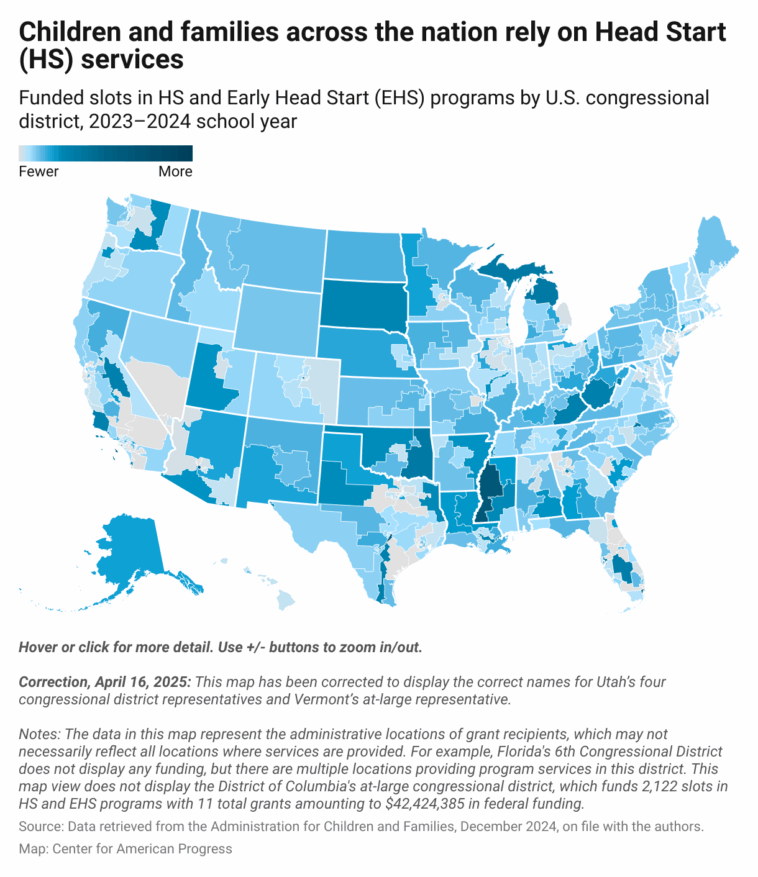
State Governors’ Appeal for Robust Early Education Funding
The Head Start program, a cornerstone of early childhood education since 1965, stands at the crossroads of policy, opportunity, and community well-being. Recent calls by several state governors to Congress underscore the need to fully fund the program, emphasizing that any cuts could disrupt preschool access and strain family support systems across the nation. This opinion editorial takes a closer look at the governors’ letter, the challenges that accompany early education funding, and the broader implications for families, educators, and the economy.
While the issue may seem straightforward on its face, the policy debate is laden with tricky parts and tangled issues that stretch far beyond a simple budgetary debate. In many ways, the discussion touches on the fine points of public welfare, economic vitals, and the subtle parts of child safety systems in low-income communities.
Governors Uniting for Early Education Funding
A group of 16 state governors – all Democrats – have come forward with a united request to fully fund the Head Start program in the coming fiscal year. Among those lending their voice is Arizona Governor Katie Hobbs, who notably identifies Head Start as a lifeline for children and families in need. Other governors, such as Colorado’s Jared Polis and New Mexico’s Michelle Lujan Grisham, have echoed these sentiments, reinforcing the national importance of early childhood programs.
The letter signed by these governors, addressed to leaders of the appropriations committees in both the House and Senate, stresses that Head Start is more than a preschool initiative. It is a comprehensive system of early education, nutrition, health, and parent involvement aimed at leveling the playing field for nearly 800,000 children nationwide. In Arizona alone, over 17,000 children benefit from these services—an indication of how widespread and critical the program has become.
Key Signatories and Their Commitments
The governors involved in this effort include:
- Governor Katie Hobbs (Arizona)
- Governor Jared Polis (Colorado)
- Governor Michelle Lujan Grisham (New Mexico)
- Governor Ned Lamont (Connecticut)
- Governor Matt Meyer (Delaware)
- Governor JB Pritzker (Illinois)
- Governor Andy Beshear (Kentucky)
- Governor Janet Mills (Maine)
- Governor Wes Moore (Maryland)
- Governor Maura Healey (Massachusetts)
- Governor Tim Walz (Minnesota)
- Governor Kathy Hochul (New York)
- Governor Josh Stein (North Carolina)
- Governor Bob Ferguson (Washington)
- Governor Tony Evers (Wisconsin)
- Governor Lou Leon Guerrero (Guam)
This coalition of state leaders is sending a clear message: Head Start is not just a program for early education—it is a critical component of the social safety net that helps keep families employed while providing essential early development for children.
Economic Implications and Family Well-Being
The governors argue that underfunding Head Start would lead to far-reaching consequences that extend into the economy, workforce stability, and community health. They describe a situation where millions of parents could be forced to choose between their jobs and providing care at home—a dilemma that turns into both a personal tragedy and a broader economic challenge.
From an economic standpoint, fully funding Head Start is a key measure to ensure a robust and balanced workforce. With many parents relying on the program as a form of child care, any disruption threatens not only family income but also the stability of the labor market. In turn, a weakened workforce could slow down economic growth and innovation. The interconnected nature of these issues highlights the need to manage public funds carefully while addressing the confusing bits and complicated pieces inherent in the budgeting process.
Workforce Impact and Child Safety Systems
The letter from the governors raises concerns over the “disruption” that could arise should Head Start funding be reduced. Among their worries are:
- Childcare Strains: Without sufficient programs like Head Start, parents may face overwhelming challenges finding safe, affordable childcare—a concern loaded with potential issues both at home and in the workplace.
- Workforce Challenges: Parents may be forced to choose between staying in their jobs and caring for their children at home, leading to a talent drain and reduced productivity in many sectors.
- Strained Health and Human Services: Reduced funding could cause a domino effect that increases the pressure on community health systems and child safety networks—a situation that is both tense and nerve-racking.
Each of these areas, when cut into the fabric of society, sets the stage for long-term socioeconomic hindrances that require careful consideration and timely action by lawmakers.
Early Childhood Education: A Multifaceted Lifeline
Head Start is well known not only for its role in initiating early learning programs but also as a support mechanism for families. With over half a century of history, the program lays a foundation for early learning that fosters academic and social skills. However, the effectiveness of Head Start is tethered to its funding stability, which provides the platform for its diverse initiatives.
Program Components and Community Impact
The Head Start program encompasses a range of services that work together to build a nurturing environment for children. These services include:
- Educational Enrichment: Offering age-appropriate instruction that sets children on a path for academic success.
- Health and Nutrition: Providing routine health check-ups, access to nutritious meals, and guidance on preventive care.
- Social and Emotional Development: Assisting in the formation of healthy social practices and emotional coping mechanisms.
- Parent and Family Engagement: Empowering parents with resources and opportunities to support their children’s development, thereby reinforcing community ties.
Beyond the classroom and clinic, the role of Head Start extends into the broader community by lessening the pressure on both local health and human services and by improving overall child safety. The benefits are multi-layered: by helping families find their way through tricky parts of daily life, Head Start serves as a cornerstone for stability and growth both at the micro and macro levels.
Dissecting the Budget Puzzle: Tricky Parts and Tangled Issues
One of the most complicated pieces of the Head Start debate is the challenge of balancing the federal budget while addressing immediate social needs. Early education funding is not without its tricky parts, and this discussion is loaded with several layered issues that merit a closer look.
Understanding Budget Prioritization
The process of determining federal spending priorities is like navigating a maze full of twists and turns. Lawmakers must balance competing demands, from national defense and healthcare initiatives to infrastructure projects and education. When it comes to Head Start, the stakes are high for families who depend on the stability and comprehensive services the program offers.
Some of the tangled issues include:
- Resource Allocation: Deciding how much of the federal budget can be safely allocated to early childhood education without neglecting other critical sectors.
- Short-term vs. Long-Term Benefits: Policymakers often struggle with prioritizing immediate needs over long-term investments, though programs like Head Start have proven to yield significant positive outcomes for decades.
- Political Considerations: Funding debates are frequently influenced by broader partisan divides, with differing views on the role of government spending in addressing social welfare.
These factors collectively contribute to a nerve-racking decision-making process that demands both strategic foresight and a commitment to supporting community well-being.
Breakdown of Funding Implications with a Table
To clarify the complexities of this issue, consider the following table, which outlines the potential short-term and long-term consequences of either funding cuts or full funding for Head Start:
| Funding Scenario | Short-Term Implications | Long-Term Outcomes |
|---|---|---|
| Full Funding |
|
|
| Reduced Funding |
|
|
Looking at the Broader Picture: Social and Economic Benefits
Beyond the immediate need for childcare and early education, fully funding Head Start contributes to a healthier and more resilient society. The program not only sets the stage for academic success but also plays an essential role in reinforcing community bonds and fostering social mobility.
Boosting the Local Economy
Early childhood programs such as Head Start deliver significant economic advantages. When families have access to proper childcare, it enables parents to maintain steady employment. This, in turn, helps fuel local economies by providing stability and consumer spending power. In practical terms, here’s how full funding can boost the local economy:
- Increased Workforce Participation: Parents who are reassured by quality childcare are more likely to remain in the workforce, which strengthens local businesses and community vitality.
- Long-Term Educational Gains: By supplementing early learning with key developmental support, Head Start contributes to a more educated workforce, setting the foundation for greater innovations and productivity in the future.
- Reduced Social Costs: Investments in early education often result in fewer social problems later on. Communities with robust Head Start programs tend to have lower rates of crime, better public health outcomes, and reduced dependency on remedial programs.
The Impact on Child Safety Systems
There is a direct (and often underappreciated) correlation between early education programs and child safety. With robust Head Start services in place, children are monitored, cared for, and given access to necessary health services, which can preempt many issues that might otherwise arise later in life. The key benefits include:
- Early Detection of Health Issues: Regular health check-ups provided by the program help catch and address health concerns before they escalate.
- Social Support Networks: The program fosters strong ties between parents, educators, and community services, which can create an environment that is both protective and nurturing.
- Enhanced Safety Measures: Training for educators and staff on child safety and well-being further helps in building a secure environment for every child enrolled.
Addressing the Tricky Parts: Policy Challenges and Political Realities
While the benefits of fully funding Head Start are clear, the policy process is layered with confusing bits and overwhelming challenges. Lawmakers have to steer through political, social, and economic pressures that make budgeting a nerve-racking task. Here are some of the tricky parts that policymakers are contending with:
- Competing Priorities: With a federal budget that must address a wide range of needs—from national security and infrastructure to healthcare and education—the allocation of funds becomes a balancing act filled with little twists and delicate decisions.
- Economic Fluctuations: Shifts in the national economy can have ripple effects on budget decisions, sometimes leading to cuts in programs that, although essential, are seen as less immediately pressing compared to other areas.
- Political Negotiations: Budget discussions often unfold against a backdrop of partisan debates, where differing ideologies about government spending complicate the process of reaching consensus.
Lawmakers are, therefore, forced to figure a path through a budget landscape that is both intimidating and complicated. The challenge lies not only in securing the necessary funds for Head Start but also in assuring that these funds translate into tangible benefits for the communities they serve.
Exploring Funding Models and Best Practices
To tackle these challenges, policymakers could draw inspiration from models where early education funding is treated as an investment rather than an expenditure. The idea here is to emphasize long-term economic and social returns as opposed to short-term costs. Some approaches include:
- Incremental Funding Increases: Gradually adjusting funding levels can help ease the strain on state and federal budgets, while allowing time for programs to scale up efficiently.
- Public-Private Partnerships: Collaborations between government and private entities can help leverage additional resources, reduce the burden on taxpayers, and stimulate innovative approaches to delivering early education services.
- Outcome-Based Funding: Structuring funding around measurable outcomes—for example, improved literacy rates or enhanced parent engagement—can strengthen the case for continued investment in the program.
Implementing these models might require community input, regular audits, and strong oversight standards. Nonetheless, they offer a framework for how public funds can be managed in a way that addresses the little details and subtle parts of early education while smoothing out the unpredictable twists and turns of fiscal policy.
The Role of Public Opinion and Community Advocacy
The importance of Head Start has been underscored not only by state governors but also by a broad constituency of parents, educators, and community leaders who watch closely as policy changes unfold. When the funding of a program like Head Start becomes a public debate, every stakeholder—from a parent to a community organizer—has a role in shaping the outcome.
How Communities Can Get Involved
Collective action can help bridge the gap between policy challenges and practical outcomes. Communities can use a variety of methods to voice their support for fully funded early education initiatives:
- Contacting Representatives: Writing letters or making phone calls to local lawmakers can help emphasize the local need for robust early education programs.
- Community Meetings: Organizing town halls or public forums allows community members to share their personal experiences and advocate for sustained funding.
- Media Campaigns: A coordinated media effort can help raise public awareness about the essential role that programs like Head Start play in nurturing the next generation.
Case Studies: Local Success Stories
A number of communities across the country have already reaped the benefits of a well-supported Head Start program. Consider the following illustrative examples:
- Urban Revitalization: In some metropolitan areas, fully supported early education programs have boosted local employment, reduced crime rates, and stimulated economic activity.
- Rural Empowerment: Rural communities with robust Head Start services have not only provided essential childcare but also improved parental employment prospects and access to healthcare services.
- Improved Educational Outcomes: Studies have shown that children in communities where Head Start is fully funded often display better academic performance and social skills, paving the way for their future success.
Looking Ahead: Policy Recommendations and a Call for Action
The debate over federal funding for Head Start is more than a political tussle; it is about the commitment to provide essential early learning opportunities that help shape our nation’s future. With the state governors’ letter urging full funding, there is now a critical window for lawmakers to better understand the intertwined roles of education, workforce stability, and community welfare.
Key Policy Recommendations
Based on the various assessments and community feedback, several recommendations can be made to ensure that Head Start continues to thrive and deliver its many benefits:
- Full and Timely Funding: Congress should recognize the comprehensive impact of Head Start and prioritize full funding in the coming fiscal year to avoid disruptions in service.
- Structured Oversight and Evaluation: Implement regular evaluations and transparent audits to ensure that every dollar spent generates measurable improvements in child development and community welfare.
- Enhanced Flexibility for States: Allow states to tailor Head Start programs to meet local needs, ensuring that a one-size-fits-all approach does not undermine effective community-specific strategies.
- Stakeholder Engagement: Involve parents, educators, and community leaders in ongoing dialogue to continuously refine and improve the delivery of services.
These recommendations are not merely academic suggestions—they represent a roadmap for building a future where early education remains a robust support system for families, communities, and the national economy.
Policy Implications and the Road to Consensus
The call from state governors is a critical juncture for the nation’s policymakers. It is a signal to move beyond political posturing and engage in comprehensive, outcome-focused discussions. As public and private stakeholders take a closer look at how early education impacts economic and social infrastructure, there is real potential to create long-lasting change.
A multifaceted approach is needed to address what many see as a nerve-racking funding process. Policymakers must figure a path that accounts for not only the direct educational benefits but also the extended improvements in workforce participation, community engagement, and overall societal well-being.
Moreover, the debate over Head Start funding serves as a reminder that political negotiations often involve subtle details and slight differences in policy visions. What is clear, however, is that providing full funding for this program is an investment in the nation’s future—a strategy that, over the long term, can offset many of the immediate economic and social costs stemming from inadequate early education.
Conclusion: A Future Built on Early Foundations
In conclusion, the Head Start program stands as a cornerstone of early childhood education and family support—a program that has helped shape the lives of countless children since 1965. The united appeal by state governors for full funding is a call to action for lawmakers to recognize and preserve the multi-dimensional benefits that Head Start provides. It is not just about preschool access; it is about a comprehensive strategy for economic stability, workforce participation, and improved community welfare.
It is essential that policymakers, community leaders, and the public work together to support an early education system that is robust, flexible, and responsive. By ensuring that Head Start is fully funded, Congress can help forestall the tricky parts and tangled issues associated with inadequate childcare, and in doing so, guarantee that our future generations start their lives with a solid foundation.
This discussion is both a reflection of our values as a society and a reminder of the interconnected nature of education, economics, and overall community health. As we move forward, let us remember that every action taken today in support of early learning is an investment in the thriving, dynamic future of our communities and our nation as a whole.
Ultimately, fully funding Head Start is an opportunity to build a legacy of progress—a legacy that empowers parents, nurtures children, and strengthens the economic and social fabrics that connect us all. With thoughtful leadership and sustained commitment, we can ensure that early education remains a must-have resource, a guiding light through the confusing bits and complicated pieces of today’s policy debates, and a beacon for tomorrow’s success.
Originally Post From https://kiowacountypress.net/content/state-governors-urge-congress-fully-fund-head-start
Read more about this topic at
Head Start Services
Head Start Investments by State | HeadStart.gov


